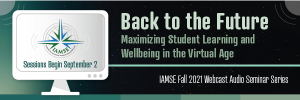
[The following notes were generated by Michele Haight, PhD.]
Presenters: Andrew Binks PhD, Associate Professor Department of Basic Science Education, Virginia Tech Carilion School of Medicine
Adam Weinstein MD, Associate Professor Medical Sciences and Pediatrics, Assistant Director Clinical Arts and Sciences, Netter School of Medicine Quinnipiac University
Reminders, Refocusing and Rethinking: Med Ed after COVID
Teaching and learning strategies in pre-clinical medical education underwent significant changes due to the rapid transition to a virtual environment prompted by the COVID-19 pandemic.
The transition from the in-person to virtual learning environment caused anxiety, frustration and social isolation for all persons involved. Because of the rapid transition, both faculty and students were underprepared for the new teaching/learning environment.
Within the new virtual format, increased student autonomy in small group learning environments resulted in positive outcomes:
- a higher level of student engagement
- increased intrinsic motivation
- increased responsibility for learning.
These attributes ultimately contributed to students’ overall successful learning.
Declining attendance at large group lectures provided an opportunity to apply the principles of autonomy to the large group learning environment. Strategies for application included:
- providing independent time for learning the basics
- allowing students to test out of certain courses
- decreasing time in the classroom
- increasing the overall value of classroom time
- employing specifications grading.
It is essential to establish a social presence online to enhance social and collaborative learning practices. Interaction with peers promotes exposure to diversity of experience and perspective. It also increases individual accountability and positive interdependence. It is necessary to expand the use of small group methods in the virtual learning space and use these opportunities to develop novel methods of small group learning.
In order to create heterogeneity of views, knowledge and experience, it is necessary to increase the accessibility of medical school through a more holistic acceptance process for applicants.
Clinical preceptorships, clerkships and Sub Is transitioned to small group video-conferencing sessions and asynchronous modules due to the pandemic. These types of sessions were useful, but not optimal, for developing communication skills, clinical reasoning skills and discussion skills. Teaching physical exam skills in the virtual environment proved to be challenging. Many medical students sought out their own service learning opportunities. Fourth year Sub-I challenges brought about positive equity changes in the residency application process.
Clinical learners demonstrated autonomous, self-directed and asynchronous learning approaches. Clinical faculty served in multiple support roles for medical students and also became developers and innovators of alternative clinical teaching approaches.
Clinical bedside learning remains an essential component for medical student training.
Medical students need to train to become clinically proficient in both the virtual and in-person environments.
Telemedicine surged during the pandemic and created a much-needed bridge to direct patient care for medical students. Telemedicine is an excellent platform for teaching observation and inspection skills through deliberate practice and meaningful feedback. Proficiency in using technology does not directly translate into proficiency in conducting a telemedicine visit.